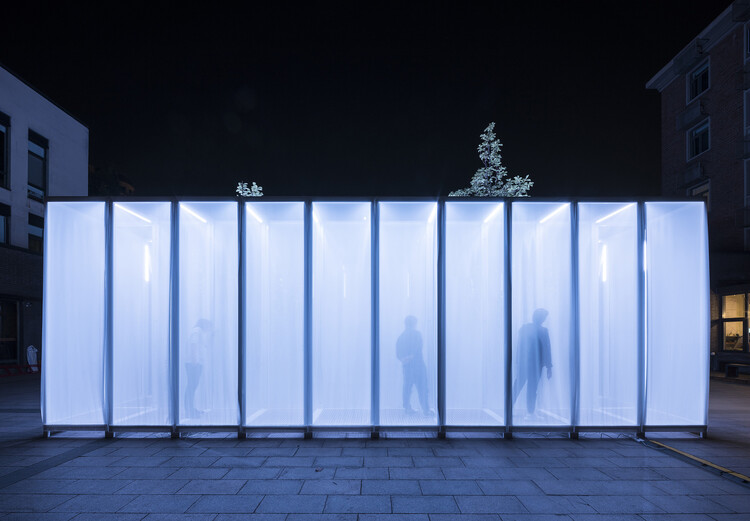
Translucency, at its essence, is an optical property that enables the total or partial passage of light through materials, without providing a clear view of the objects behind them. Despite its apparent simplicity, this property has fascinating applications in the architectural field, generating attractive and powerful proposals that play with light without obstructing views.
Traditionally, glass sheets have been the symbolic material associated with transparency, commonly used in the fabrication of doors and windows. However, technological advances in production and the exploration of innovative materials have significantly expanded the opportunities to take advantage of this property in both interior and exterior applications. These advances challenge preconceived limitations and encourage creativity in the development of novel architectural proposals.

Whether composed of textiles, plastics, or other materials, this diversity manifests specific characteristics that set them apart, thereby contributing to a distinctive aesthetic. Furthermore, in certain cases, they offer advantages for lighting and interior temperature control. For these reasons, we have compiled a series of translucent materials that stand out in the context of contemporary architecture.
Textiles and Fabrics
Textiles are renowned for their delicate appearance. While, by themselves, they may not serve as load-bearing elements, their versatility is heightened through tensioning. Combining them with a system of posts or cables that perform this structural function takes advantage of their flexibility, allowing the creation of large-format curved or flat shapes. This approach is particularly effective in comparison with rigid construction systems, opening up aesthetic and functional possibilities.
In the external environment, textiles stand out on facades and roofs, thanks to their ease of transport and lightness, coupled with their additional function as effective solar protection. Simultaneously, in interior environments, textiles can find applications in partitions, providing privacy through divisions that partially obstruct the view. In that sense, the combination of textiles and interior lighting creates striking visual effects, reminiscent of a lantern.


Glass Blocks
Since their introduction in the early 20th century, glass blocks have experienced ups and downs in their use over time. The manufacture of these partitions involves the fusion of two glass sections, creating a hollow space in the center that provides the material with thermal and acoustic insulating properties.
One of the advantages of this material is that when used in partition format, it enables the creation of translucent surfaces with greater thickness compared to a sheet of glass. In addition to its varied dimensions and modular characteristics, this material is versatile in exterior applications, serving as elements that can comprise the entire face of a facade, particularly in residential projects. Additionally, it does not require a special treatment or final finish, simplifying its use and maintenance.


Metallic Mesh
Similar to textiles, metal meshes provide a breathable alternative to glass derivatives. Their notable advantage lies in their malleability, enabling them to adapt seamlessly to complex shapes. The clarity of this material is achieved as the meshes allow light to pass through the spaces generated between the links, creating a veil-like effect.
In exterior applications, these meshes can be combined with other construction systems to form ventilated facades, while in interiors they can be used as partitions and suspended decorative elements. In both contexts, the metallic character of this material stands out, generating striking visual effects depending on the incidence of light and the combinations of shades of the links used.


Plastic
Generally speaking, plastics are known for their transparency and strength. Within this category, thermoplastics, such as polycarbonate, stand out for being light and easy to thermoform, as well as for their high resistance compared to glass systems. They find diverse applications in facades, roofs, and partitions, standing out for their insulating qualities due to the composition of air chambers that reduce heat transmission. In addition, if the disposal of polycarbonate as waste is properly managed, it can be upcycled to create new materials.
Other examples include the reuse of everyday objects made of plastic, presenting itself as not only a way to reduce our ecological footprint but also to take advantage of the expressiveness of this material and its qualities when interacting with light. This approach highlights the versatility and sustainable potential of polymers in diverse contexts.


Marble
Although it may seem contradictory due to the solidity that natural stone represents, some varieties of marble possess translucent qualities when interacting with light. This implies that, depending on its application and the light source, this material can allow light to radiate during the day on a facade and glow from within at night, for example. Furthermore, its stony nature translates into considerable benefits in terms of the material's resistance and low maintenance.
Aesthetically, its veins become powerful elements, creating patterns that add texture to architecture. This makes marble an appealing option, where its translucency and strength combine to provide both functional and visual solutions.


Compared to solid and opaque materials like concrete or wood, translucent architecture creates distinctive atmospheres, inviting exploration into diverse aesthetics and innovative functional configurations. By facilitating the incidence of light and views, these elements bring a new dimension not only in terms of privacy but also to understanding the interaction between spaces separated by them, either from the inside to the outside or as interior partitions.












